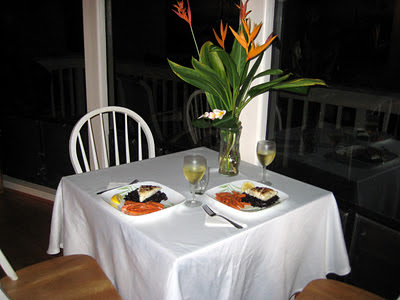After experiencing a deeply inspired pumpkin pizza at
Tuli Bistro a few weeks ago, we vowed to recreate it ourselves as a grilled flatbread. Which we haven't done yet, mostly because it's cold and dark and Novembery in the evenings outside in our grilling area, and warm and cozy and light inside in our non-grilling area, which creates a distinct bias toward non-grilling activities. Maybe next summer. In the meantime, we decided to reincarnate the pizza (or at least, its revelationary triumvirate of winter squash, cured pork, and goat cheese) in risotto form.
I don't care if you think bacon and goat cheese couldn't possibly coexist peaceably in the same dish. Neither did we. Make this anyway. Your taste buds will eventually emerge from their deliciousness-induced coma long enough to thank you.
Ingredients
One smallish butternut squash (about 2 lbs), halved lengthwise and seeds scooped out
Olive oil
4 cups veggie and/or chicken broth
1 + 1/2 strips applewood smoked bacon, divided, sliced crosswise (or sub pancetta)
1 large or two smaller leeks, white and light green parts, chopped
1 clove garlic, pressed
1 cup Arborio rice
White wine
8-10 leaves fresh sage, thinly sliced crosswise
2 handfuls arugula
Salt and freshly ground white pepper to taste
1-1.5 oz good-quality goat cheese
Garlic chives, for garnish (or sub regular chives)
Preheat the oven to 425°F. Cut each squash half crosswise into half-inch strips. Arrange in a single layer without crowding on a large, nonstick or foil-lined baking sheet lightly brushed with olive oil. Roast in the oven for 25-40 minutes or until lightly golden on both sides, turning the slices about halfway through. When the squash are tender, remove from oven and let cool. Peel the slices and cut into bite-sized rectangles.
Heat the broth in an uncovered pot over medium heat. When it simmers, turn the heat down slightly and let simmer, uncovered, as you make the risotto so that it reduces slightly.
Meanwhile, heat a large pot or dutch oven over medium heat. Add the half strip's worth of bacon and cook, stirring from time to time, until it starts to turn golden. Turn the heat down just a bit, add the leeks, and continue to saute until they soften. Stir in the garlic and saute for another 20-30 seconds, then add the rice and stir to coat evenly with the bacon-leek-garlic mixture.
Saute the rice for about a minute, then pour in a ladleful of white wine. Let cook, stirring occasionally, until the liquid is absorbed, then add a ladleful of broth. Continue to add broth by the ladleful, stirring and allowing the liquid to absorb before adding more.
Meanwhile, heat a frying pan over medium heat. Add the bacon and fry until golden, then drain off the excess fat and add just a light drizzle of olive oil in its place. Turn off the heat, throw in the sage, and stir a couple times to combine.

When you have just one or two ladlefuls of broth left and the risotto is just tender, fold in the arugula and pour a ladleful of broth over the top to help it start to wilt. Continue to cook, stirring, for another minute or two until the arugula is just wilted. Add in the squash and allow to heat through, then gently stir in the bacon-sage mixture. If the risotto seems dry, add a little more broth. Turn off the heat, and add salt and white pepper to taste.
Serve on preheated soup plates, with goat cheese crumbled over the top. Garnish with snipped garlic chives.
Serves 2, and pairs well with Pinot Noir like
Talbott's 2009 Kali-Hart from Monterey County, available at our
co-op.





































